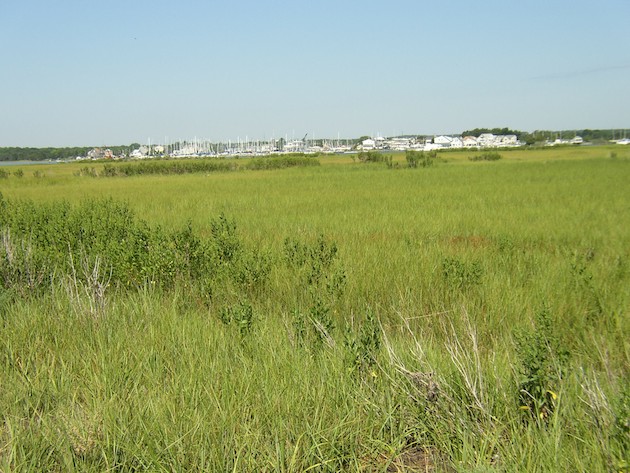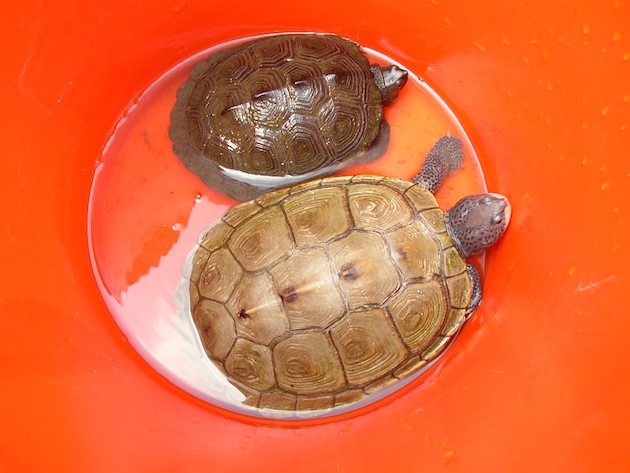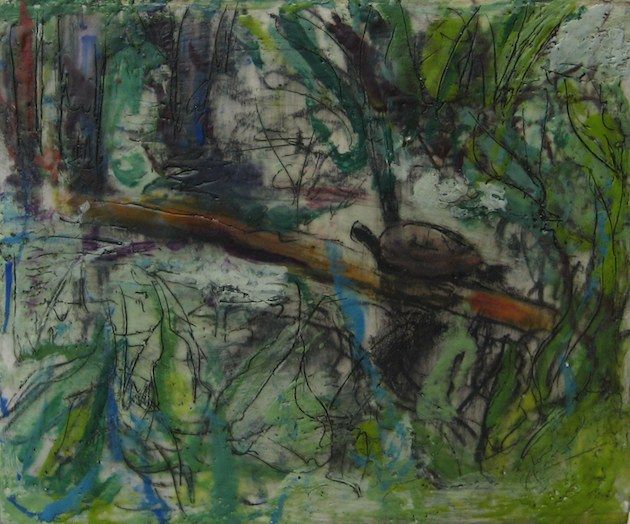I reek of insect repellant, but it is doing me no good. The bugs seem to come in shifts. First the familiar buzz of mosquitoes, followed in short order by small black gnats, flitting around my face. I swat the back of my head and neck with my baseball cap and wave my hands in front of my face in an effort to ward them off.
It’s only midmorning, but the humid August air is already close to a hundred degrees. The heavy rubber chest waders I’m wearing trap the heat and sweat against my body, making it feel even hotter.
We push off from the dock, two graduate students and two Earthwatch volunteers in a 14-foot aluminum boat, and putter by the homes that line this quarter-mile channel leading to southern New Jersey’s Barnegat Bay. I’m startled by a golden retriever barking at us from one of the small, tidy backyards about 20 feet away.
We speed up at the end of the channel, leaving the mosquitoes, gnats, and barking dogs behind as we head out into the open bay. As we accelerate, I feel a welcome breeze, but my joy is soon interrupted by a sharp pain in my arm. I slap at it; the greenhead fly that bit me escapes, then immediately comes back for another try, joined by several companions. I squash one of the half-inch insects, and blood, presumably my own, splatters everywhere.
Welcome to the salt marsh.
I’ve often viewed salt marshes from a distance, while driving along coastal roads in my native Massachusetts, but I’ve never gone into one. As a biologist, I enjoy exploring and learning about new environments and relish the chance to see species of plants and animals I’ve never seen before, but I usually gravitate toward more exotic ecosystems, such as deserts and jungles.
I’m in Barnegat Bay for a week, volunteering on a research project studying diamondback terrapins, a species of turtle that inhabits salt marshes, mangrove swamps, and estuaries from Texas to Cape Cod. The group I’m with, Earthwatch Institute, is a nonprofit that pairs paying volunteers with scientific research projects around the world; the program gives researchers an alternative to more traditional funding sources, such as the National Science Foundation or university grants, and it also provides scientists with labor to help carry out their fieldwork.

I volunteered on a number of Earthwatch projects in the 1980s, before going to graduate school, and enjoyed working with scientists in the field, studying sharks in the Bahamas, black bears in North Carolina, and sea turtles in the Caribbean, as well as other projects. Since then, I have assisted with field courses in such places as Central and South America, Australia, and the desert Southwest and worked on field research projects, such as herpetology surveys in Massachusetts.
The scientists leading this study are from Drexel University in Philadelphia. I worked with them a few years earlier on another Earthwatch project in the Mojave National Preserve in California, studying desert tortoises. When I heard about their new research project, I saw it as a chance to reconnect with a great research team and to explore and learn more about salt marshes, a common ecosystem but one I knew little about. And as a herpetologist, someone who studies reptiles and amphibians, I also saw it as an opportunity to learn something about a reptile species I’d never seen in the wild: diamondback terrapins.
Having survived overfishing during a stint as a gourmet delicacy in the early 20th century, diamondback terrapins are now suffering a familiar litany of human-related pressures across their geographic range: pollution, habitat destruction, boat and car strikes, and the crab traps that pose the risk of drowning. The long-term ecology project that I’m helping with will gather data to analyze the effects of human pressures on the terrapins of Barnegat Bay and help scientists develop a long-term conservation plan for the species along the crowded New Jersey coast.
Our project is what field biologists call a mark-recapture study, where the terrapins are captured, then brought back to the lab to be weighed, measured, marked, sexed, and aged, before being turned loose back into the salt marsh; any subsequent recaptures will let the researchers track changes in the turtle’s vital stats, such as size and weight.
Having survived overfishing during a stint as a gourmet delicacy in the early 20th century, diamondback terrapins are now suffering a familiar litany of human-related pressures.
We will measure the length, width, and depth of each turtle’s shell using calipers. The shell also provides a convenient way to mark the turtles, by filing a series of notches into its outer edges. Each terrapin gets its own unique pattern of notches, and as a secondary identifier the turtles have a numbered tag injected under their skin; later, it can be scanned to ID the animal and compare the new data to existing records. The researchers also record the GPS coordinates of where each turtle was captured, to get an idea of its home range.
The Drexel scientists and students also monitor the terrapins’ nesting patterns, marking the sites where they’ve dug their nests and, in some cases, putting protective fencing around the nests to protect the eggs from raccoons and other predators. Hatching success—how many eggs hatch out of the total number laid at a given nest site—and hatchling survival estimates can also be determined as part of the study.
Data from mark-recapture studies helps provide biologists with a demographic overview of a given population of animals—how large the population is, how many males vs. females there are, how many older, reproductive adults there are vs. juveniles, etc.—which in turn lets researchers know if the population is healthy and stable or in decline and in danger of possible local extinction. This information can then be used to develop a conservation plan for a given species within a given geographic area.
The project provides me with a glimpse into the lives of these fascinating animals. And even though long-term ecology projects can last for decades, volunteering on this research effort, even for a short time, allows me to contribute in a small way to the conservation of the diamondback terrapins and the salt marsh habitat they live in.
After a 10-minute ride, Claire, the soft-spoken 20-something graduate student piloting our boat, exits the open water of the bay and maneuvers into one of the many channels that meander through the marsh. She cuts the engine about 10 feet from shore, and the boat glides to a gentle stop against the muddy bank. Jumping from the bow, I plant the anchor in the thick, spongy soil composed of equal parts mud, peat, and tangled roots.
Nutrient-rich salt marshes like these serve as important nurseries for many species of fish, mollusks such as clams and mussels, and crustaceans, like shrimp and crabs. Terrapins, birds, larger fish, and even mammals like raccoons and otters take advantage of the salt marsh’s varied menu.
Foot-high spartina, also known as cordgrass, dominates the landscape, an endless green field stretching in all directions, obscuring the water from view. At the far end of the marsh, a couple of miles away, condos and marinas, with their armada of boats, encroach on this fragile ecosystem.
The spartina crunches under the heavy rubber soles of my waders. Without the breeze from the moving boat the heat is intense. After walking 100 yards or so, we come to a channel about 50 feet wide, with a large, heavy net stretched across it in a shallow V, leading to a barrel-shaped turtle trap in the middle. The net is vertical and extends from the surface of the water to the bottom, providing a barrier that funnels the turtles toward the trap in the middle. The trap itself is composed of steel rings about 3 feet in diameter, with sides made of netting. Metal poles driven into the mud and tied to the trap hold it in place, keeping the top of the trap above water at high tide so the turtles won’t drown. The opening of the trap is funnel-shaped and points inward, much like a crab or lobster trap, which allows a terrapin to swim in but not back out.
I sit down on the grass-covered bank, then slip into the murky, waist-deep, 80-degree water. It provides little relief from the heat. As I start to walk toward the center of the channel and the trap, I sink about a foot into the soft mud. I try to lift one foot, and then the other, but it isn’t working. The harder I pull, the more suction seems to be generated and the deeper the opposite foot sinks.
“I’m stuck!” I shout.
Claire wades over to me and hands me a wooden paddle she’s been carrying. She instructs me to hold onto the top of the handle and shove the paddle end into the mud, to give myself an extra push and help free one foot. I move painstakingly forward through the mud, one paddle-assisted step at a time.
The mud stinks of rotten eggs thanks to the sulfur released by decomposing organic matter. There’s no shade to protect us from the summer sun, and dripping sweat stings my eyes. Our friends the greenhead flies keep buzzing us as well. I’ve been in some pretty harsh environments before—hot, humid jungles, 120-degree deserts—but this is brutal. Who would have thought a salt marsh in New Jersey would be so inhospitable?
My sunglasses, lenses blocked by an opaque blend of sunblock lotion, insect repellant, and sweat, are useless; I tuck them into my shirt pocket. I start to feel claustrophobic. All I want to do is peel off the hot, heavy layer of rubber that encloses me.
Field research, as a formal scientific endeavor, dates back hundreds of years, to early naturalists and explorers like 18th-century Swedish botanist, zoologist, and physician Carl Linnaeus, who set about cataloging species of plants and animals and devised the modern system of scientific nomenclature, whereby organisms are given two names, one for genus and one for species, such as Homo sapiens for humans. The diamondback terrapin’s scientific name is Malaclemys terrapin.
In the 19th century, famed English naturalist Charles Darwin made the ultimate field research project out of his epic journey around the world. Observations of the various species of organisms he saw in the Galapagos Islands, such as mockingbirds and finches, and how they differed from mainland South American species, and in particular from island to island, helped spawn his theory of evolution.
The greenhead fly that bit me escapes, then immediately comes back for another try, joined by several companions.
Although the focus of biological research has shifted to the lab over the past several decades, field research is still important, perhaps now more than ever, with growing human populations, climate change, and ever greater human-induced pressure on the natural world.
Biologist Yoel Stuart, who recently completed his doctorate in organismal and evolutionary biology at Harvard University, and is now a postdoctoral researcher at the University of Texas at Austin, told me in an email that field research is important for a variety of reasons, including practical applications directly related to human health and technology. For example, scientists researching the Ebola virus, currently raging in West Africa, need to track the virus to its source by finding out which wild animal species are harboring it and transmitting it to humans, in order to protect against future outbreaks.
“Many advances in science and technology have arisen because biologists were spending time in the field observing or collecting plants, animals, fungi, and microbes in nature,” said Stuart. “Many of our pharmaceuticals, especially antibiotics, are based on compounds found in organisms collected from the wild.”
But Stuart said the most salient reason scientists conduct field research, sometimes even in unpleasant working conditions, is just because they like it.
“We like being surprised by nature. We enjoy watching an organism conduct some behavior in the field that we could have never seen in the lab. We enjoy finding organisms living in places we never would have expected them, like kilometers under the Antarctic ice. We enjoy the adventure of getting to new places and discovering species new to science. We take great pleasure in understanding how species interact with each other in the wild as they find food, avoid predators, reproduce, and pass genes on to the next generation. Nature never ceases to amaze, so we always return to nature, where we pursue knowledge for knowledge’s sake. To many of us, that’s worth bloody knuckles, scraped shins, whining mosquitoes, simultaneous sunburn and hypothermia, ticks on the delicates, and mud in the ears.”
Just as I can’t bear the heat, bugs, and mud any longer, Claire shouts, “We’ve got some!”
I can see the trapped terrapins’ dark, thumb-sized heads poke above the surface of the water briefly, then disappear with a swirl. My physical discomfort recedes; excitement and curiosity take over. Claire pulls the terrapins out one by one and passes them to Julie, another graduate student, who puts them in an orange plastic bucket for transport back to the lab where they’ll be weighed, measured, and marked.
There are six turtles in this trap: four females, 7 to 8 inches long, and two males, about 5 inches each. This size difference between males and females, a phenomenon called sexual dimorphism, is typical for terrapins, Julie tells us.

I pick one up to examine it. I’ve never held a wild terrapin before. Its carapace, the top of the shell, is gray. The diamond-shaped plates that cover the carapace, called scutes, give the diamondback terrapin its name and have ridges that look like they’ve been carved from wood. The underside of the shell, called the plastron, feels and looks like smooth, hard wood and is orange-yellow in color, a sharp contrast to the gray skin of the turtle’s head and legs.
The feisty reptile struggles to break free, scratching my hands and forearms with quarter-inch claws and snapping at me with the whitish beak that lines the edge of its jaws, which it usually uses to crush the mollusks and crustaceans, such as snails and small blue crabs, that make up much of its diet.
“Be careful,” Claire warns. “They can bite pretty hard.”
I place it in Julie’s bucket. After removing all the terrapins, the grad students empty the bycatch from the trap. There are a few blue crabs, a delicacy along the Mid-Atlantic coast. They dance about at the bottom of the trap, pincers raised in a defensive position. There are also several fish—white perch, summer flounder, croakers, and sea trout—species I haven’t seen since I was a kid in North Carolina. The flapping pile of fins and scales brings back memories of fishing piers on the inland waterway at Camp Lejeune and late nights surf fishing with my dad at Cape Hatteras.
“Oh, we caught a needlefish,” says Claire.
“A needlefish?” I ask with surprise. I look down to see a slender, 12-inch fish with a long, pointy beak and silver-blue iridescent scales glistening in the sunlight. It flaps around a little and snaps its jaws, gasping for oxygen. I remember seeing needlefish darting between the pilings of piers in Florida, but never in New Jersey, and I’ve never seen one up close like this. The unexpected find is almost magical.
Claire turns the needlefish loose, and it darts from sight.
Claire and Julie bait the trap with fresh pieces of cut fish and set it back in the water. We wade back to the boat, carrying our bucket of terrapins.
As the boat motors back to the dock, I think about the hot, humid, muddy, buggy, physically uncomfortable aspects of the salt marsh and the fascinating life that thrives beneath the water. Field biologists endure occasional discomfort to pursue their passion, whether that passion is collecting data to answer a scientific question, or addressing an environmental problem, or just seeing something new. And in exchange for the bug bites, and the heat, and cold, and scratches, and sweat, they might be rewarded by a glimpse of something special, something magical in its own right—a rosy boa crossing a road in the Mojave Desert at night, a flock of scarlet macaws flying across a remote part of the Brazilian Amazon at sunset, or even a diamondback terrapin, or a needlefish, in a salt marsh in New Jersey.



